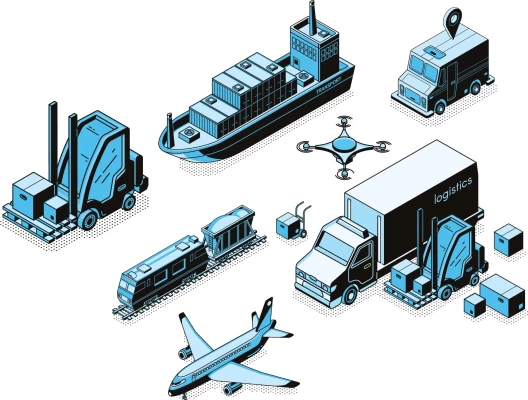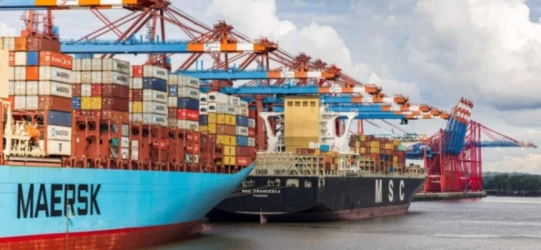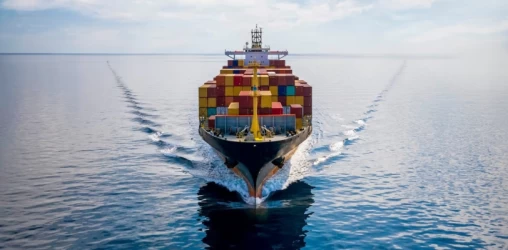A Comprehensive Overview of Iran’s International Transport: Maritime, Air, Road, and Rail
Iran's Maritime Transport with Various Countries
Iran, due to its strategic geographical location and access to open waters, plays a key role in international trade and transit corridors. Major ports like Shahid Rajaee and Chabahar are pivotal in the maritime transport network. Below is an analysis of Iran's maritime interactions with different countries.
- Maritime Transport Between Iran and Russia
- Iran and Russia are connected through the Caspian Sea, with ports such as Anzali, Noshahr, and Astrakhan playing crucial roles. Their cooperation within the North-South Corridor facilitates the transit of goods from India and the Persian Gulf to Russia and Europe. Additionally, the use of the Volga-Don Canal enables Iran to access the Black Sea for transporting goods.
- Iran-India Maritime Cooperation
- Chabahar Port, located in southeastern Iran, plays a vital role in the East-West corridor and is developed in cooperation with India to access Afghanistan and Central Asia. This port provides a strategic alternative to Pakistani routes and offers India faster access to regional markets, promoting economic collaboration between Iran, India, and Afghanistan.
- Iran’s Cooperation with European Countries
- Iran collaborates with European countries within international frameworks such as the International Maritime Organization (IMO). These interactions focus on developing port infrastructure, removing administrative barriers, and digitalizing maritime transport. Iran aims to enhance the capacities of Shahid Rajaee and Chabahar ports to position itself as a trade gateway between Europe and Asia.
- Connection with China and Central Asia
- Iran is a part of China’s "One Belt, One Road" initiative, which connects Iranian ports to East Asia's transport networks, boosting trade with Central Asia and the Caucasus. Additionally, northern Iranian ports like Amirabad are expanding to support goods transfer to Central Asia.
- Challenges and Opportunities in Iran’s Maritime Transport
- Sanctions: Economic sanctions are a significant challenge for Iran's maritime sector, limiting access to shipping services and trade interactions.
- Port Expansion: Iran is expanding its port infrastructure to handle larger trade volumes, with Shahid Rajaee being developed to become the largest container port in the region.
- Digitalization: Iran is working on digitalizing administrative processes at ports to facilitate trade with international partners.
Iran’s Air Transport with Various Countries
Air transport plays a crucial role in connecting Iran with the world, facilitating trade, tourism, and cargo movements through domestic and international airlines. Below are some key collaborations and routes in Iran's air transport network.
- Air Transport with Neighboring and Middle Eastern Countries
- Iran has extensive air connections with neighboring countries such as Turkey, Qatar, the UAE, Oman, and Iraq. These routes are among the busiest due to geographical proximity and economic significance.
- Iran-Turkey: Frequent flights operate between Tehran, Mashhad, and Turkish cities like Istanbul and Antalya.
- Iran-UAE: Strong air links exist between Iran and Dubai or Abu Dhabi, serving both trade and tourism.
- Air Connections with European Countries
- Iran operates air routes to Germany, France, the UK, Austria, and Italy. These flights serve both tourism and cargo transport. Airlines like Iran Air and Mahan Air use these routes.
- Iran-Germany: Iran maintains regular flights to Frankfurt and Munich.
- France and the UK: Despite political challenges, limited flights operate between Tehran and Paris or London for diplomatic and commercial purposes.
- Expanding Air Cooperation with Africa and Asia
- Iran-Nigeria: Recent agreements include passenger and cargo flights between Tehran and Abuja, Nigeria’s capital.
- China and Malaysia: Iran operates flights to cities like Beijing and Shanghai, driven by joint economic projects, while routes to Malaysia and Thailand cater mostly to tourism.
- Importance of Cargo and Commercial Flights
- Iran plays a significant role in cargo air transport, especially with China and Europe. Cargo flights transport industrial and medical goods, ensuring regional supply chain continuity. Agreements like those with Nigeria, allowing unlimited cargo capacity, highlight Iran’s focus on expanding long-distance trade relations.
- Challenges and Prospects for Iran’s Air Transport
- Despite expanding collaborations, the Iranian aviation industry faces challenges, including international sanctions and technical limitations on the fleet. However, Iran aims to solidify its position in international air transport by upgrading its fleet and signing new agreements.
Iran’s Road Transport with Various Countries
Road transport between Iran and neighboring countries is essential for trade and cargo movement. Iran, situated at the heart of regional transit corridors, connects to Asia, the Middle East, Europe, and the Caucasus through land borders. Below are the key corridors, agreements, challenges, and prospects in Iran’s road transport sector.
- Key International Corridors Passing Through Iran
- Iran lies on several crucial international transit routes:
- North-South Corridor (INSTC): This route connects Iran to Russia, the Caucasus, and India, facilitating goods movement between Asia and Europe and reducing transport time from Europe to South Asia.
- East-West Corridor: This corridor links Iran to China, Turkey, and Europe. Iranian trucks play a role in China’s Belt and Road Initiative, moving goods westward.
- Road Transport with Neighboring Countries
- Iran’s road transport network with neighboring countries is crucial for fast goods transfer. Key routes include:
- Iran-Turkey: One of the busiest trade routes, with Iranian and Turkish trucks moving goods between Asia and Europe.
- Iran-Iraq: Industrial goods and food products are exported to Iraq, one of Iran's largest export markets, through land borders like Mehran and Shalamcheh.
- Afghanistan and Pakistan: Road routes to these countries support the export of industrial products, food, and fuel.
- International Road Transport Agreements
- Iran has signed agreements with various countries to facilitate road transport, focusing on reducing customs fees and easing transit routes. Key agreements include:
- With the Eurasian Economic Union: Facilitating transit through Iran to Russia and Kazakhstan.
- With Central Asian Countries: Iran collaborates with Turkmenistan, Uzbekistan, and Tajikistan to move goods to East and North Asia.
- Challenges in Iran’s Road Transport
- Sanctions: Sanctions increase transport costs and create difficulties in fleet maintenance.
- Aging Infrastructure: Some routes suffer from outdated infrastructure, reducing the speed and efficiency of goods movement.
- Customs Issues: Bureaucratic hurdles and border restrictions slow down transit in certain cases.
- Future Prospects for Iran’s Road Transport
- Iran seeks to strengthen its role as a regional transit hub by improving infrastructure and enhancing international cooperation. Investments in new road projects and efforts to join international transport agreements aim to secure Iran’s future in the sector. Collaboration with China in the Belt and Road Initiative and expanding routes to Europe are among Iran’s strategic goals.
Iran’s Rail Transport and International Connectivity
Rail transport is a crucial part of Iran’s infrastructure, connecting Asia to Europe and the Persian Gulf. Iran’s railway network plays a key role in several international transit corridors and is undergoing continuous expansion. Below are the main corridors, agreements, challenges, and prospects for Iran’s rail transport.
- Key Rail Corridors and International Routes
- Iran is connected to multiple countries through rail corridors, including:
- North-South Corridor (INSTC): Connecting Iran with Russia, Azerbaijan, and India, this corridor aims to transport goods from Bandar Abbas to Astara, and further to Russia and Europe.
- East-West Corridor: Linking Iran with China and Turkey, this corridor is part of China’s Belt and Road Initiative. Chinese goods enter Iran by rail and continue to Turkey and Europe.
If you have any specific questions or need further assistance, feel free to ask!











